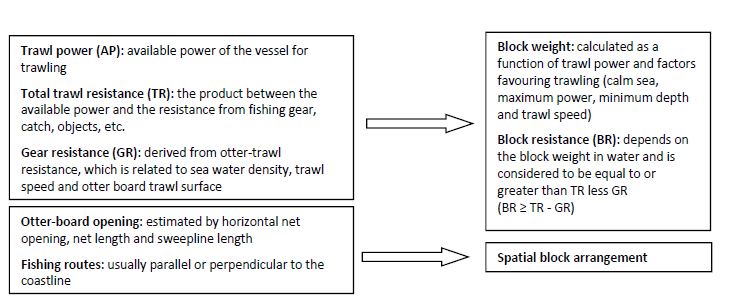5.1 Protection artificial reefs
5.1.1.Objectives
The main purpose of this type of artificial reefs is to act as a dissuasion tool for fisheries (i.e. illegal trawling) and as a protection tool for marine resources, environment and other legitimate activities.
This application is frequently used to protect habitats of ecological interest or of importance for some life stages of some resources (e.g. Posidonia beds, maerl beds, coralligenous, biogenic reefs, reproduction and nursery areas, sensitive and essential fish habitats, etc.) from illegal trawling, dredging and bottom purse?seining that can damage both the habitat and its associated resources. The use of appropriately?designed artificial reefs may help control and reduce conflict between trawling and coastal small?scale fisheries using set gear.
Some protection artificial reefs can be used to protect other structures like cables, oil or waste water pipelines thereby preventing pollution damage.
5.1.2.Design and material
Protection artificial reefs should be specifically designed to withstand the power of fishing vessels in an area and to either hook nets or tear them up. Therefore, the units must be heavy enough to steadily maintain their position on the seabed and avoid removal by fishing vessels. Several artificial reefs have failed because the modules were shifted or hauled up by the fishing vessels. Consequently, protection units should be dense and relatively low profile, with a low volume in relation to their weight. The weight should be related to the power of the fishing vessels to be stopped. Concrete blocks with deterrent arms are usually employed (Fig. 2).

Figure 2. Examples of protection units: A) Spain; B) France; C) Tunisia (modified from J.J. Goutayer Garcia, E. Charbonnel and N. Haddad).
Figure 3 shows the technical parameters to be considered in designing protection artificial reef units. A good review of the technical characteristics for the design of protection artificial reef units is provided in Ramos?Espla et al. (2000).

Figure 3. Variables to be considered when designing anti?trawling reef units (modified from Ramos?Espla et al., 2000).
5.1.3.Siting
Considering the extended area typically covered by protection artificial reefs, planning the location of the units on the seabed requires detailed knowledge of several features of the seafloor such as the distribution of natural habitats and the position of man?made structures (pipeline, cables, etc.) in order to protect them, avoid damages and prevent negative impacts.
It is also essential to know the fishing routes in the area in order to strategically place modules along designated lines perpendicular to the routes. The distance between modules should be less than the otter?board/dredge openings, hence than the free space needed by the vessel to pass with the towed gear between one module and the other, taking into account the best relationship between the artificial reef’s effectiveness and costs. Usually, these modules are placed alternate along two or three parallel lines.
When protection artificial reefs are deployed to create suitable grounds for selective small? scale fisheries and to protect the resources from other less selective fishing activities, the reef units should be placed following a spatial design which allows for the use of set gear within the reef area.
Several protection artificial reefs have failed in their protection function because the units were haphazardly dropped from the sea surface and, hence, became scattered on the seabed without following a specific design. Therefore, the use of GPS combined with controlled release of the modules by crane can assure their correct positioning and effectiveness.
5.1.4.Practical applications
Several examples of this application exist in the Mediterranean Sea (e.g. Spain, Tunisia).
Spain
The development of artificial reefs in Spain is motivated by the need to protect coastal fishing resources, high?diversity biological communities and selective small?scale fisheries against the action of non?selective fishing methods like trawl and seines.
More than 130 artificial reefs have been constructed along the Spanish coasts since 1989, most of them for protection purposes, as a tool for Spanish fisheries policies. Along the Mediterranean coast, the depth of deployment ranges from 10 to 35 m – sometimes up to 50 m. The projects developed in Spain for protection artificial reefs have tried to optimize the design of units to improve their function and optimize both the number of units and their arrangement on the seafloor (Fig. 4). The goal was to protect as much area as possible minimizing costs and habitat modifications. Cost reduction was also achieved using maritime conventional means to install the reefs without the intervention of divers.
The results indicate an increase of local fishing resources, a reduction of conflicts between fishers and, in some cases, a significant recovery of natural habitats.
Reef 1Figure 4. Scheme of a protection artificial reef (Spain). The protection units are placed along three lines perpendicular to trawlers navigations routes (red arrows) to protect the Posidonia and
Cymodocea beds (green area) inshore and leave space for artisanal fishing activities (modified from J.J. Goutayer Garcia).

Figure 4. Scheme of a protection artificial reef (Spain). The protection units are placed along three
lines perpendicular to trawlers navigations routes (red arrows) to protect the Posidonia and
Cymodocea beds (green area) inshore and leave space for artisanal fishing activities (modified from J.J. Goutayer Garcia).